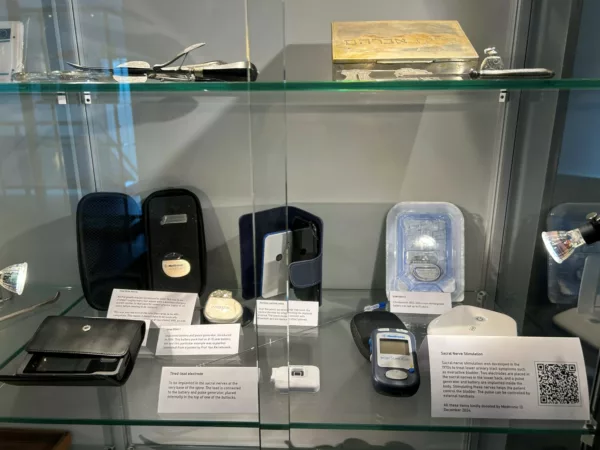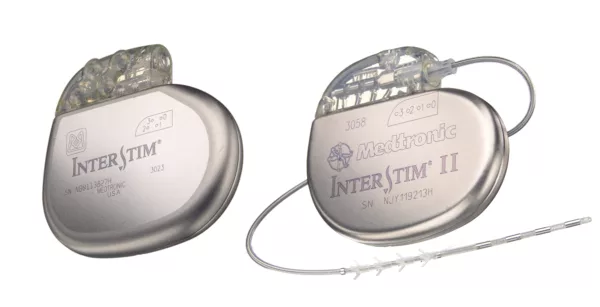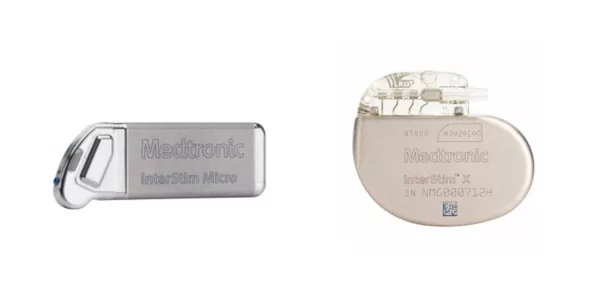The EAU Permanent History of Urology Collection receives neuromodulation hardware donation
During the annual ‘Fall Meeting’ of the EAU History Office in Leiden, the Netherlands in October 2024, a mini-symposium on historical urological topics was held. One of the lectures dealt with the history of (sacral) neuromodulation for bladder and bowel dysfunction.
On that occasion the Dutch office of Medtronic Inc. presented an overview of the currently available implantable materials (hardware) for sacral nerve neuromodulation (SNM) therapy, but also some ‘historical’ types of batteries and electrodes that have been in clinical use since 1994. As one of the early implanters of these SNM systems, this collection brought back to me vivid memories of the pioneering years of neuromodulation as a functional urological therapy.
The members of the board of the EAU History Office, in an unanimous action, asked the representative of Medtronic if there would be a possibility to acquire this collection for the EAU Permanent History of Urology Collection at the EAU headquarters in Arnhem. After some internal consultation, the representative of Medtronic announced that the whole collection would indeed be donated to the EAU. At the occasion of a working meeting of the EAU History Office in December of 2024, the collection was handed over by Mrs. Madeline Kroesbergen and added to one of the showcases together with some documentation on the neuromodulation hardware and the different techniques used.
It is great to have such an addition to the collection, as we want, beside presenting the antique instruments that illustrate the enormous developments within Urology, also preserve and show more recent examples of urological technology.
InterStim
The first commercially available system (battery and electrode) for sacral neuromodulation (InterStim system, Medtronic Inc., Minneapolis, Minnesota, USA) received CE mark (approval to market in Europe) for the management of chronic functional disorders of the pelvis and lower urinary and intestinal tract in 1994. It received FDA approval in 1997 for the treatment of urgency incontinence, followed in 1999 by the FDA approval for the treatment of urgency-frequency and severe voiding dysfunction/urinary retention, followed in 2011 for use in patients with faecal incontinence.
The first recharge-free implantable pulse generator (IPG) battery for clinical SNM was the InterStim I, followed in 2006 by the InterStim II IPG, which was lighter and had a lower volume, allowing for smaller incisions and pockets, hence reducing operating time and post-operative pain.
In 1998 a specific SNM lead electrode, to be fixed in the sacral foramen, received FDA approval. A major step was the development in 2003 of a self-anchoring tined lead electrode that allowed for percutaneous placement without fascial anchoring, making the procedure much less invasive and reducing operation time.
In 2020, a miniaturised, rechargeable, full-body MRI compatible IPG, the InterStim Micro, was launched, together with a MRI-compatible tined lead electrode. Finally, in February 2022, the Medtronic InterStim X IPG received FDA approval, providing a recharge-free battery lasting up to 15 years.
In a bit more than 30 years implantable technology for SNM evolved significantly and allowed the move from an open procedure under general anaesthesia to a percutaneous intervention, that is possible under local anaesthesia or sedation.
We are very pleased that we can show the full range of these technical developments in the Permanent History of Urology Collection at the EAU Central Office in Arnhem. This material shows the developments that currently allow us to treat patients with functional problems of the lower urinary tract in an efficient way with minimal morbidity and few complications.
If you would like to know more on the history of (sacral) neuromodulation for bladder and bowel problems, we refer to this open access article (1) and you can look forward to an upcoming episode of the EAU Podcast that will cover the history of the use of electricity in urology.
Reference:
- Van Kerrebroeck PhEV, van den Homberg U. The history of neuromodulation for lower urinary tract dysfunction: An overview. Continence Volume 11, September 2024, https://doi.org/10.1016/j.cont.2024.101328


